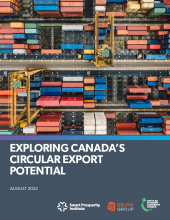Given the highly globalised nature of the world economy, trade can play an important role in driving the circular economy transition. This is particularly important for a natural resource producing and exporting nation like Canada.
As of yet, Canada’s core competitive advantages have been in clean energy and natural resources, a strong business environment, and an educated labour force. However, with emerging international policies on the circular economy such as the EU’s Circular Economy Action Plan and the forthcoming global plastic pollution treaty, many of Canada’s major trading partners and competitors are beginning to position themselves for a future which embraces circularity, decarbonization and resource efficiency. Therefore, in the coming years, demands from Canada’s international trading partners are likely to start shifting towards more sustainable goods and services.
Thus, Canada risks falling behind in global market share and innovation if it does not make strides in developing its circular export offerings. A circular economy may also present opportunities to diversify trading relationships with countries that are not currently engaged in trade with Canada but are seeking more sustainable trading partners.
To date, there has been no analysis done on the scale or scope of the trade opportunity the global circular economy transition offers Canada. There is also a dearth of research on how well positioned Canada might be to capitalise on the opportunity. Exploring Canada’s Circular Export Potential is intended to be a first step towards filling that gap. It does this by:
-
Providing an overview of what circular solutions may look like in five selected sectors: mining, plastics, construction, the bioeconomy, and crosscutting enabling technologies.
-
Offering a high-level scan of policy, business, and consumer trends that are spurring the demand for such circular solutions and identifying existing or emerging Canadian industry solutions that could be leveraged to meet this demand.
-
Identifying areas for further research and offering preliminary recommendations for government action.



